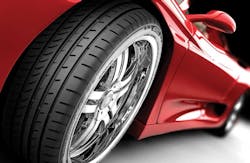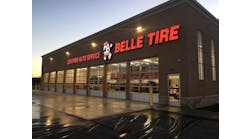New car manufacturers are continuing to drive the UHP tire trend. According to the 2013 Modern Tire Dealer Facts Issue, original equipment tire shipments have steadily increased from 34.6 million units in 2010 to 40.7 million in 2012, when many OEMs released new models with ultra-high performance fitments.
“UHP use by OEMs grew in 2012,” says Tom Gravalos, vice president of marketing and original equipment, Pirelli Tire North America Inc. “All current indications are that UHP use by OEMs will continue to grow in 2013.”
The Rubber Manufacturers Association (RMA) forecasts a nearly 4% growth in OE tire shipments for 2013. The 1.7 million additional units are anticipated due to projected total light vehicle sales of greater than 15 million — about a 700,000 unit increase compared to 2012.
As new car OE fitments continue trending toward higher wheel diameters and lower aspect ratios, the number of UHP tire sales as original equipment sizes will continue to grow.
“The percentage of UHP tires at OE rose in 2012 with more growth forecasted in 2013 and beyond, based on what we saw at the LA Auto Show,” says Scott Sulsberger, regional sales manager with Nexen Tire Americas Inc. “For example, in 2012 Ford introduced their new Fusion model (2013 model year). The premium OE size option in the new design was a 235/40R19, an upgrade from the 225/45R18 offered in 2011 (2012 MY).”
“The UHP penetration in the market continues to rise year over year,” says Scott Jamieson, director of product management, Cooper Tire & Rubber Co. “There was a greater than 4% increase in the UHP replacement market from 2011 to 2012. We are expecting the UHP OE and replacement market to steadily increase over the next several years.”
According to Bob Liu, product manager, performance tires for Continental Tire the Americas LLC, OE percentages of V-rated and higher passenger UHP tires were higher in 2012 compared to 2011, and represented approximately 29% of the passenger tire OE shipments.
For W- and Y-rated tire shipments, the OE percentage of passenger UHP tires was approximately 4% in 2012, slightly lower than the previous year, according to Liu. “We do not expect a significant change in the UHP percentage for 2013.”
[PAGEBREAK]
Precise demands
Part of what drives the UHP tire trend at the OE level is the demand for greater precision vehicle performance.
“The trend exists for the continued growth of the V and Z (149 mph and higher) market as greater precision is expected in the vehicle’s ability to go, stop and turn,” says David Shelton, director of marketing for GITI Tire (USA) Ltd. “Whether you refer to that expected precision as performance or handling, the benefits are found in UHP products.”
Shelton says the UHP trend is even taking hold with light trucks intended for street and highway use.
Today’s UHP tire buyer is either an enthusiast or an innocent bystander. It’s no wonder the buyer isn’t clearly defined; the vehicles they are purchasing that come with UHP tires are in a state of flux also.
“The continued emergence of the CUV market has contributed to the growth of UHP sizes offered as original equipment,” says Nexen’s Sulsberger. “For example, in 2012 the popular Nissan Pathfinder changed from a truck-based SUV to a CUV base. The 2012 version’s top option was a 265/65R18. In the 2013 CUV model, the Platinum Edition upgraded to a 235/55R20 option.”
Plus-sizing: plus, minus or mainstream?
As we move into the twenty-teens, UHP tires and the vehicles they go on continue to evolve alongside a consumer who falls into two distinct categories (see story on page 22). As if that weren’t enough to keep track of, now there’s another aspect of the UHP market that is in a state of flux.
“Plus-sizing has changed from where it was in the mid-1990s,” says Cooper’s Jamieson. “I would say that there is a plus-size market but it has evolved from huge 22- to 28-inch sizes to more plus-one or plus-two fitments. We see the market being supported by select import vehicles (BMW, Lexus, Mercedes-Benz, Nissan, etc.) and high-performance vehicles from the Big Three, such as Camaro, Mustang, Charger and Challenger.”
Jamieson says that many times these owners will keep the same wheel diameter but change the tire size.
“For example, with an OE size of 275/40R20, the owner will change the tire to a 305/35R20. This change satisfies the owner’s plus fitment and personalization needs. If these owners increase the wheel diameter, they usually plus-one or plus-two size, but usually not over a 20-inch fitment.”
While Jamieson admits there is still a 22-inch-and-greater plus fitment market, it is small and has become more of a niche market. He says these larger fitments coming from the factory satisfy the market demand and are slowing down plus-size aftermarket sales.
“Ten years ago, ‘plus-sizing’ meant changing from OE-offered fitments to one- to five-inch larger wheels,” says Chet Plewacki, TBC Wholesale product marketing manager. “Now you see OEs offering packages of ‘plus sizing’ right from the factory, even on lower-end/non-sport models as consumers want the look of UHP sportiness but not the cost, noise, etc., that comes with it.”
[PAGEBREAK]
GITI’s Shelton believes that as more OE vehicles are offered with multiple rim diameters and styling packages, dealer-installed plus-sizing tendencies for new passenger cars is diminishing.
“Aftermarket plus-sizing for previously owned vehicles still exists,” says Shelton. “The trend to see ‘more wheel, less sidewall’ is still on the rise throughout the passenger and performance segments. Aesthetics are a key driver for consumers, and in the SUV and light truck segment, that trend carries through on the performance and street vehicles.”
“There does appear to be an OE influence in this area — i.e., as more new cars come standard with large diameter tires and wheels, there may be less reason to opt for plus-size aftermarket fitments,” says Goodyear’s Foote. “At any rate, the previous fast growth of 21- to 24-inch diameters (extreme sizes) has leveled off.”
“Plus sizes still exist,” says Hankook Tire America Corp. “However, given the more intricate systems and development for increasingly sophisticated vehicles targeting more specific consumers, a change is occurring. The change is that given more targeted vehicles, the OE product is often better-suited for the vehicle than the replacement product.”
“Plus sizing is declining at the replacement level as it is now prevalent at the OE level,” says Rick Brennan, vice president of marketing at Kumho Tire U.S.A. Inc. “More 19-inch and larger rim sizes are coming OE, which means less people are opting for replacing them with larger wheels in the aftermarket.”
According to Doug Brown, sport UHP brand category manager at Michelin North America Inc., an owner needs to be careful that the need for plus sizing takes into consideration the load of the vehicle and the tire pressure to carry that load.
“Today, with the sophistication of suspension and electronic systems that read the rolling diameter of the tire and wheel assembly, coupled with the packaging of the car, plus sizing for performance is more difficult.”
Brown says that plus-sizing for cosmetic reasons complicates the experience for the owner as the larger and typically heavier assemblies like the suspension and brakes can’t be managed by the vehicle.
“The traditional notion of ‘plus-sizing’ has changed as car manufacturers outfit their vehicles with larger wheels and tires right out of the factory,” says John Hagan, senior director of sales, Toyo Tire U.S.A. Corp. “Now, a vehicle owner may just be replacing their 18- to 20-inch tires versus plus-sizing up to that size.”
Hagan says that for that reason, the sizes that once were plus sizes are really mainstream sizes and the number of applications and the sales volume continues to grow.
“There will always be the builders and customizers doing more extreme plus-sizing with wider, narrow and bigger tires, and we develop tires and sizes with them in mind, too,” says Hagan. “As the economy recovers and people have more discretionary income, we anticipate the demand for upgrading and customizing will grow.” ■
See also:



